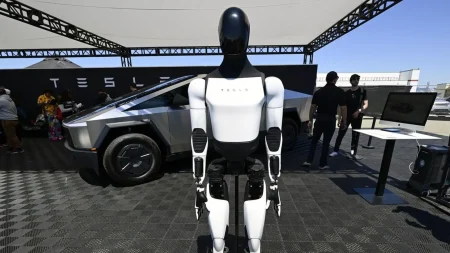From Crypto Mining to AI Powerhouse: The Meteoric Rise of CoreWeave
In a remarkable journey from humble beginnings to tech industry giant, CoreWeave has transformed from a small cryptocurrency mining operation into a $50 billion company at the forefront of AI infrastructure. Under CEO Michael Intrator’s leadership, CoreWeave now manages a vast empire of 250,000 GPUs across 33 data centers, serving tech giants like Microsoft, OpenAI, and Meta. This extraordinary growth has minted several billionaires, including Intrator himself, now worth $6.7 billion, and co-founder Brian Venturo at $4.2 billion. Their success stems from recognizing early that the GPU stockpile they originally used for crypto mining could be repurposed to meet the explosive demand for AI computing power. The company’s unconventional path – pivoting from crypto, securing creative financing through GPU-backed loans, and forming strategic partnerships with Nvidia – has positioned it as an essential player in the AI infrastructure landscape.
CoreWeave’s ascent began in 2017 when Intrator and co-founders Venturo and Brannin McBee started mining cryptocurrency with GPUs in a Manhattan office that became so hot they feared it might catch fire. After crypto crashed in 2018, they made a pivotal decision: rather than chasing volatile cryptocurrency markets, they would focus on the equipment itself. They swapped their mining GPUs for data center-grade chips and began offering computational power for various applications including 3D rendering and early AI projects. Their first major break into AI came through a collaboration with Eleuther AI in late 2021, followed by work with Stability AI, creator of the viral text-to-image generator Stable Diffusion. Recognizing the enormous business opportunity emerging in AI, they sought financing to purchase thousands of Nvidia’s advanced chips. When ChatGPT catapulted AI into the mainstream in late 2022, their gamble paid off spectacularly, with demand for their services skyrocketing.
What truly set CoreWeave apart was Intrator’s innovative approach to financing. Spurned by venture capitalists who thought they were “insane” to compete with established cloud giants, Intrator turned to “East Coast money” – debt markets. His financial innovation came in convincing investors like Magnetar Capital to provide loans secured by the very GPUs he was purchasing. This creative financing model allowed CoreWeave to acquire vast quantities of advanced chips without diluting the founders’ equity stakes. The strategy gained significant momentum when Nvidia CEO Jensen Huang took notice of their massive chip purchases in late 2022, leading to a pivotal investment that granted CoreWeave “elite” status in Nvidia’s partner network and priority access to cutting-edge chips. This symbiotic relationship with Nvidia – simultaneously vendor, investor, and customer – has been instrumental in CoreWeave’s explosive growth, though critics point out the power imbalance, with one analyst bluntly stating: “CoreWeave wouldn’t exist if Nvidia didn’t want it to.”
As the company scaled up, its financial commitments grew exponentially. CoreWeave secured multiple rounds of debt financing, including $2.3 billion led by Blackstone in 2023 and a staggering $7.5 billion in 2024. These funds enabled them to fulfill massive contracts with tech giants, notably a reported $10 billion deal with Microsoft through 2030 and a $15.9 billion commitment from OpenAI over five years. The company has continued its aggressive expansion, recently acquiring AI software developer Weights & Biases for $1 billion and planning a $9 billion acquisition of data center owner Core Scientific. However, this rapid growth has come with considerable financial strain – the company reported net losses of $860 million in 2024 and $605 million in the first half of 2025, while carrying $11.2 billion in debt with interest rates ranging from 7% to 15%. Despite these concerning financials, Intrator remains defiant toward skeptics, insisting that each contract is structured to generate approximately $2 of revenue for every dollar of debt to be repaid.
CoreWeave’s business model faces several significant challenges that could threaten its continued success. Chief among these is the company’s heavy reliance on debt financing, with some credit rating agencies categorizing its latest bonds as junk and analysts expressing concern about potential debt levels reaching $30 billion within two years. The company also faces significant customer concentration risk, with Microsoft accounting for 62% of its 2023 revenue. Additionally, tech giants are rapidly building their own infrastructure – Microsoft plans to spend $80 billion on data centers in 2025 – while emerging competitors like Crusoe, Nebius, and Lambda Labs are securing contracts with CoreWeave’s existing clients. Local opposition to data center projects presents another obstacle, with residents in Lancaster, Pennsylvania already protesting CoreWeave’s planned $6 billion facility over concerns about power consumption and environmental impact. Perhaps most significantly, the company’s entire business model hinges on the continued exponential growth of AI – if the current AI boom proves to be a bubble that bursts, CoreWeave could be left with idle servers and insurmountable debt.
Despite these challenges, Intrator and his team remain steadfastly optimistic about CoreWeave’s future. They contend that their contracts are structured to cover costs and generate profit, with some analysts forecasting the company could reach profitability as early as next year. CoreWeave is diversifying both its customer base and business model, expanding beyond infrastructure to invest in AI startups with combinations of cash and GPU access. The company’s market capitalization has more than doubled since its March IPO, outperforming the broader Nasdaq. While skeptics worry about the sustainability of the AI boom and CoreWeave’s debt-heavy approach, Intrator remains convinced that his GPU-backed financing strategy will continue to pay dividends as AI compute demand grows. The company’s journey from a sweltering Manhattan office mining cryptocurrency to a multibillion-dollar enterprise powering the AI revolution represents one of the most remarkable business transformations of the AI era. However, its future success ultimately depends on whether the current AI frenzy represents a genuine technological revolution or merely another tech bubble waiting to burst.















